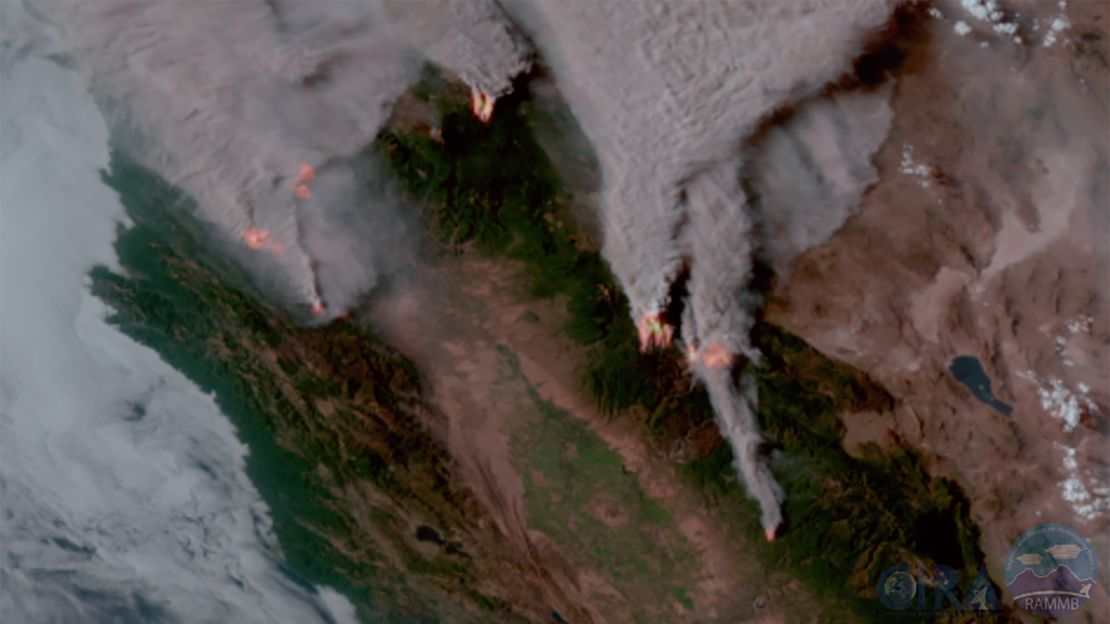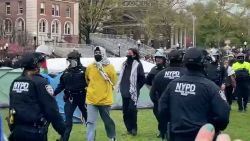A newly ignited fire in Northern California has forced thousands of residents to evacuate their homes as the US fights 96 large active fires that have scorched nearly two million acres.
The River Fire, raging in Nevada and Placer counties in California, has destroyed or damaged 80 structures since it started Wednesday, according to Cal Fire. It has already torn through 2,400 acres and was not contained at all Thursday afternoon.
In Placer County, nearly 2,400 people are under evacuation, Placer County Sheriff’s Office spokesman Nelson Resendes said. In Nevada County, at least 4,200 residents are under an evacuation order or warning, Nevada County Sheriff Shannan Moon said.
“If you receive an evacuation warning, please go. And if you receive an order, get out. Do not take your chances … We do not need you in there; you’re taking your life in your hands,” Placer County Sheriff Devon Bell said Wednesday at the news conference.
Fire fighters have been frustrated by residents not heeding evacuation orders, officials said Thursday.
“When our resources come in and they have to load up people in their vehicles, in their fire vehicles, and put them in a safe spot, that takes us away from fighting the fire,” Jake Cagle, an operations section chief for California Incident Management, said in a briefing Thursday.
“We have firefighters getting guns pulled out on them because people don’t want to evacuate,” he said.
Gov. Gavin Newsom on Thursday declared a state of emergency in three northern counties because of the River Fire and the Antelope Fire, which has burned more than 20,000 acres since it was first reported August 1.
Meanwhile, California’s largest active wildfire – the Dixie Fire – has torn through Greenville, destroying about 75% of the historic town in Plumas County, also in the state’s northern region.
Video of the fire shows flames ripping through the wooded terrain, cars charred, and structures burning – including a gas station along a main road.
“The Dixie Fire burnt down our entire downtown,” Plumas County Supervisor Kevin Goss wrote on Facebook on Thursday. “Our historical buildings, families homes, small businesses, and our children’s schools are completely lost. Every square inch of downtown holds countless memories for each member of our small community and an ample amount of history from our ancestors.”
“I am at a loss for words, and my heart goes out to every one of you that suffered loss, evacuated, and weary on what is to come,” wrote Goss.

Residents of the town were warned earlier to evacuate immediately.
“If you are still in the Greenville area, you are in imminent danger and you MUST leave now!! … If you remain, emergency responders may not be able to assist you,” the Plumas County Sheriff’s Office said in a message.
Wednesday evening, responders were still working to get everyone out.
“Right now, there are still a lot of people unfortunately in Greenville that did not evacuate. And so, we are having to deal with that … and get all those folks out,” said Jake Cagle, the operations sections chief for California’s Incident Management Team.
In an emotional video posted on Facebook, U.S. Rep. Doug LaMalfa – who represents the area where the Dixie Fire is burning – said more needs to be done and more attention needs to be paid to what the fires are doing to communities.
“We lost Greenville tonight. And there’s just not words for how us in government haven’t been able to get the job done,” La Malfa said. “We will take up the fight even harder. And more so, we got to win this; we got to stop this. We got to get DC to pay attention, we got to get Sacramento to pay attention.
“Forget the politics, forget the nonsense. We have to stop making this happen by inattention to what is obvious,” LaMalfa said.
Currently, there are 11 large active fires in the Golden State that have seared 425,944 acres so far, according to the National Interagency Fire Center.
This wildfire season in the state continues to outpace last year’s record season, with almost 400,000 more acres burned across the state than at the same time in 2020.
“Compared to this same time last year, we have seen an astounding 151% increase in acres burned across California and it is only August!” Cal Fire said in a tweet Thursday. “Now is the time prepare you and your family by having your go bag ready.”
Only Oregon has more large active fires at 15. The state is the site of the largest active wildfire in the US: the Bootleg Fire.
Wildfires in the US are being fueled by extreme drought, above normal temperatures, and low humidity.
North of the border, in British Columbia, Canada, 292 wildfires were actively burning as of Wednesday, with 122 categorized as out of control, the British Columbia Wildfire Dashboard showed.
Hawaii battles its largest wildfire yet
Even being surrounded by water hasn’t kept Hawaii free from fires.
Two homes have been destroyed in the Mana Road Fire, Hawaii’s largest wildfire on record, the state’s Department of Land and Natural Resources (DLNR) said.
The fire has burned between 40,000 and 50,00 acres, fueled by wind gusts that topped 50 mph over the weekend, said Mike Walker, Fire Protection Forester with the DLNR Division of Forestry and Wildlife.
The fire is now 75% contained, but the fight isn’t over, Walker said. “Firefighters will probably be there a few more days securing the line and tending to any hotspots they find.”
While most people think of Hawaii as a tropical place, the leeward side of the island is drier, and Hawaii has a year-round fire season, Walker explained. Climate change has contributed to greater risk of fires in fallow agricultural lands, he said.
“The wet seasons are getting wetter and this creates a lot more fuel in the grass lands in these old agricultural lands and the drought that follows the wet season cures the grass until its ripe for burning,” Walker said.
He cited the decline of agricultural lands as adding this significant fuel to the landscape, which devoid of crops is rich with invasive species of grass from Africa.
The cause of the Mana Road Fire has not been determined, but Walker noted that natural fires are rare, and 99% of fires started in Hawaii are caused by humans.
Federal forest officials abandon ‘let it burn’ tactic after criticism
The US Forest Service will no longer use its “let it burn” strategy for wildfires after federal officials allowed a small fire to grow out of control in extreme drought conditions, destroying homes and prompting renewed criticism from western lawmakers.
The “managed fire” suppression strategy, colloquially known as “let it burn,” came under scrutiny again last month after Forest Service officials decided not to quickly extinguish the lightning-sparked Tamarack Fire in a national forest south of Lake Tahoe that later went on to destroy at least 10 structures and burn nearly 70,000 acres in two states.
The decision prompted backlash from lawmakers in both California and Nevada, including Gov. Newsom, who told President Joe Biden in a virtual meeting last month that the Forest Service has a culture that “too often is wait and see.”
“We need your help to change the culture in terms of the suppression strategies in this climate literally and figuratively to be more aggressive on these federal fires,” Newsom told Biden.
US Forest Service Fire Chief Randy Moore cited severe drought, limited resources and firefighter fatigue in a memo Monday, after more than a year of almost constant deployments and assisting with Covid-19 vaccination efforts.
“The 2021 fire year is different from any before,” Moore wrote. “In short, we are in a national crisis. At times like these, we must anchor to our core values, particularly safety.”
Moore said the agency will continue to prioritize extinguishing wildfires that could pose a threat to public safety, and will not use planned small fires to clear out overgrown forestlands until wildfire activity improves.
“We are in a ‘triage mode’ where our primary focus must be on fires that threaten communities and infrastructure,” Moore wrote. “There is a finite amount of firefighting resources available that must be prioritized and fires will not always get the resources that might be requested.”
US Agriculture Secretary Tom Vilsack, who met with Newsom on Wednesday at the burn scar of the August Complex Fire, the largest wildfire in California history, pledged more firefighting resources and acknowledged the federal agency’s firefighting strategy was in need of change.
“Candidly, I think it’s fair to say over the generations, over the decades, we have tried to do this job on the cheap,” Vilsack said, lamenting that the action “has caught up with us.”
Vilsack praised Newsom for challenging the federal government to do more and promised to “beef up capacity with more boots on the ground” and ensure that federal firefighters are better compensated.
“This is music to our ears,” said Newsom.

























